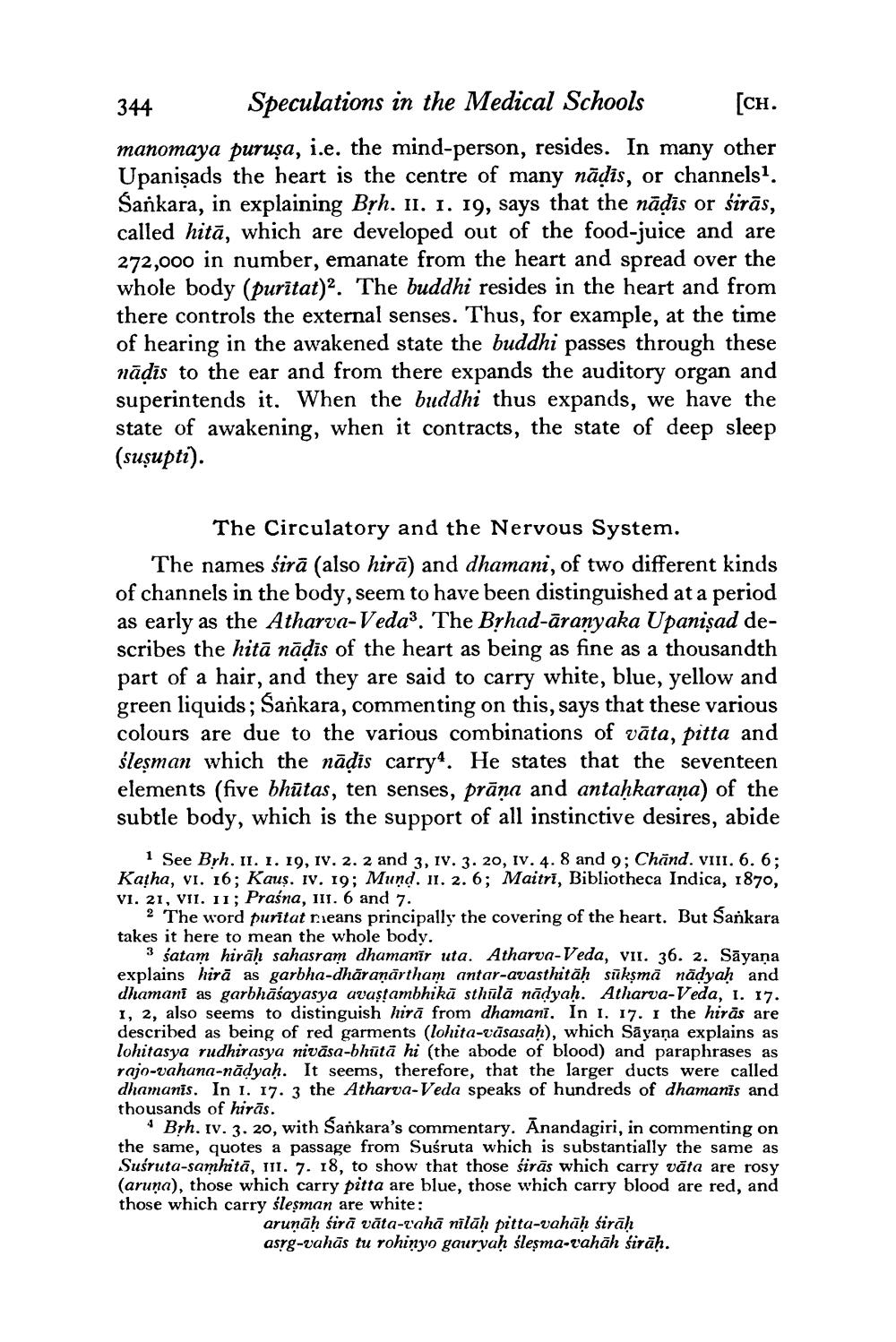________________
Speculations in the Medical Schools
[CH.
manomaya puruşa, i.e. the mind-person, resides. In many other Upanisads the heart is the centre of many nāḍīs, or channels1. Sankara, in explaining Brh. II. 1. 19, says that the nāḍīs or sirās, called hitā, which are developed out of the food-juice and are 272,000 in number, emanate from the heart and spread over the whole body (puritat)2. The buddhi resides in the heart and from there controls the external senses. Thus, for example, at the time of hearing in the awakened state the buddhi passes through these nāḍīs to the ear and from there expands the auditory organ and superintends it. When the buddhi thus expands, we have the state of awakening, when it contracts, the state of deep sleep (suşupti).
344
The Circulatory and the Nervous System.
The names sira (also hirā) and dhamani, of two different kinds of channels in the body, seem to have been distinguished at a period as early as the Atharva-Veda3. The Bṛhad-aranyaka Upanisad describes the hitā nāḍīs of the heart as being as fine as a thousandth part of a hair, and they are said to carry white, blue, yellow and green liquids; Sankara, commenting on this, says that these various colours are due to the various combinations of vata, pitta and śleşman which the naḍis carry1. He states that the seventeen elements (five bhūtas, ten senses, prāṇa and antaḥkaraṇa) of the subtle body, which is the support of all instinctive desires, abide
1 See Brh. II. 1. 19, IV. 2. 2 and 3, IV. 3. 20, IV. 4. 8 and 9; Chand. vIII. 6. 6; Katha, vi. 16; Kaus. IV. 19; Mund. 11. 2. 6; Maitri, Bibliotheca Indica, 1870, VI. 21, VII. 11; Praśna, III. 6 and 7.
2 The word puritat means principally the covering of the heart. But Sankara takes it here to mean the whole body.
3 satam hirah sahasram dhamanir uta. Atharva-Veda, vII. 36. 2. Sāyaṇa explains hirā as garbha-dharaṇārtham antar-avasthitaḥ sūkṣmā nāḍyaḥ and dhamani as garbhāśayasya avaṣṭambhikā sthūlā nāḍyaḥ. Atharva-Veda, 1. 17. 1, 2, also seems to distinguish hira from dhamani. In 1. 17. I the hirās are described as being of red garments (lohita-vāsasaḥ), which Sāyaṇa explains as lohitasya rudhirasya nivasa-bhūtā hi (the abode of blood) and paraphrases as rajo-vahana-nadyaḥ. It seems, therefore, that the larger ducts were called dhamanis. In 1. 17. 3 the Atharva-Veda speaks of hundreds of dhamanis and thousands of hirās.
4 Brh. IV. 3. 20, with Sankara's commentary. Anandagiri, in commenting on the same, quotes a passage from Suśruta which is substantially the same as Suśruta-samhita, III. 7. 18, to show that those siras which carry vata are rosy (aruna), those which carry pitta are blue, those which carry blood are red, and those which carry śleşman are white:
aruṇāḥ śirā vāta-vahā nīlāḥ pitta-vahāḥ śirāḥ asṛg-vahās tu rohinyo gauryaḥ śleṣma-vahah sirāḥ.




